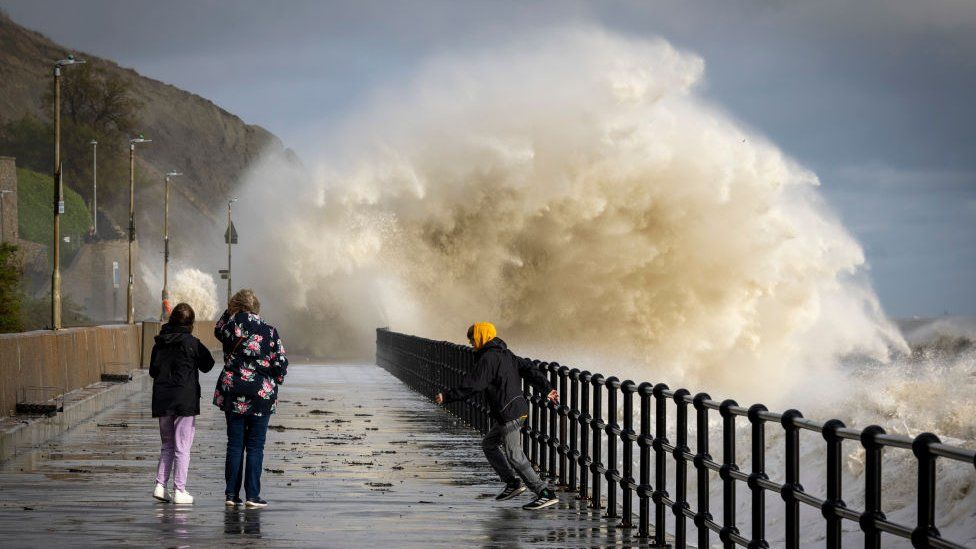ARTICLE AD BOX
 Image source, Getty Images
Image source, Getty Images
As climate change makes the weather more unpredictable, weather apps are using more technology to try to keep up
By Suzanne Bearne
Technology reporter
Travelling the world by bicycle for two years might be too physically challenging for most of us, but Zoe Ashbridge has found a way to make the pedalling a little bit easier.
She and her partner and travelling companion Stewart use an app called Windy to track the direction of the wind.
"We use it daily," says Zoe, a 33-year-old from Shropshire who is on a career break. "It saves us wasting time and energy.
"Our bikes weigh around 30 to 40kg, and if we're going against the wind, we can get sore knees. It prevents all that. Why spend two hours cycling when the next day it would take 30 minutes?"
Weather apps are continuing to become ever more detailed and bespoke, as technology and artificial intelligence continue to develop. It means more real-time updates and personalised recommendations.
Image source, Zoe Ashbridge
Image caption,Zoe Ashbridge and her partner Stewart use a weather app to avoid cycling into headwinds
"Forecasting models have become more accurate... and that's certainly due to tech advancements," says Steven Smith, chief executive of US-based Accuweather. His business has been forecasting weather since 1962, when its first customer was a natural gas company that wanted to be able to better plan for winter demand.
"The ultimate goal at the extreme end is to help save lives and protect property, all the way to helping people make the best weather impact decisions, for example, 'do I need an umbrella, do I need to leave early?'."
Over at the UK's Met Office, one of its biggest tech developments over the last year has been improving its digital weather maps and the data it pours into them.
"You can see where the weather is moving in real time, and where it's coming towards you," says Sophie Yeomans-Smith, product manager at Met Office's app. "If there's a huge downpour you can look at the live rain forecast and see where it's heading.
"We've been improving the tech underpinning it all, and changed host providers to help us make improvements. It used to be one day ahead that it would show, now it's five days."
In a bid to tailor its products more, the Met Office has introduced dedicated beach and mountain forecasts. "With the beach forecast, it tells you how windy it is, what the waves are going to be like... and we have partnered with RNLI [the Royal National Lifeboat Institution] on it," says Ms Yeomans-Smith.
"The mountains data says things like what the weather at the top of the mountains, and at ground level, will be like."
Image source, Sophie Yeomans-Smith
Image caption,Sophie Yeomans-Smith says the Met Office now offers members of the public more real time data
Meanwhile, the Met Office announced in August that it had joined forces with Scottish airline Loganair to further bolster its forecast accuracy. Sensors fitted to Loganair's aircraft monitor environmental conditions around the planes during flights.
This data is said to help the Met Office both better predict extreme weather and pinpoint localised thunderstorms and fog.
Eric Floehr is founder of ForecastWatch, a US company that analyses and collates the performance of weather providers, including accuracy measures. He says weather forecasters are continuing to put more attention into communicating as quickly as possible, against a backdrop of climate change making weather patterns more changeable.
"Tech improvements have resulted in improvements to forecasts, they're more accurate and reliable. These days people are using them multiple times a day, there's more real-time application of weather forecasting, looking at creating alerts in the next few minutes and hours.
"[Yet], it's harder for forecasters to identify extreme weather, as it's rare, but there is more interest and attention paid to 'how do we better predict the extreme weather?'. However I think start-up funding has lacked in this area."
He suggests that the lack of financial backing for such new weather app firms is, ironically due to weather. More specifically - because the Silicon Valley region of northern California, home to many tech investors, does not typically suffer from climate extremes.
"It's notable that Silicon Valley does not have [changeable] weather, meaning that its venture capitalists don't think about investing in it," he says.
New Tech Economy is a series exploring how technological innovation is set to shape the new emerging economic landscape.
Back at Accuweather, Mr Smith says it started building artificial intelligence (AI) databases back in the late 1980s, to help predict weather patterns. It now also uses AI to automatically translate its reports into different languages.
"We have global audience with over 100 languages and dialects, so all these different products have to be converted into number of different languages which can be consumed by users," he says. "The newest way of using AI is around language generation and putting phrases together, which can be very detailed. It could be concerning flooding, if the commute might be a problem."
Mr Smith add that Accuweather is also investing more in making sure users are informed of severe weather and air quality.
"A lot of what we're doing is continuing to focus on health and safety," says Mr Smith. "More people are attuned to air quality, for example the impact of going outside for a run. We can show what the air pollution forecast will be, what the [ground level] ozone and other irritants will be."
He also says that if there is a wildfire, the company can predict the direction of the smoke, the severity, and the temperature. "It's about enhancing warnings and visualisations."
Returning to Zoe Ashbridge and her global bike ride, she says she has now used the Windy app in 27 countries. "If I see a fellow cyclist struggling against the wind, I'll tell them about it."

 1 year ago
36
1 year ago
36








 English (US) ·
English (US) ·